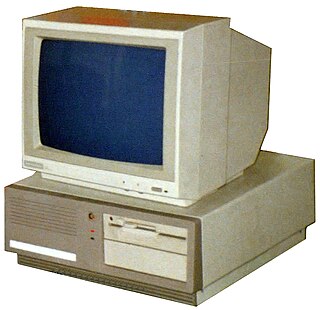
The Extended Industry Standard Architecture is a bus standard for IBM PC compatible computers. It was announced in September 1988 by a consortium of PC clone vendors as an alternative to IBM's proprietary Micro Channel architecture (MCA) in its PS/2 series.

Industry Standard Architecture (ISA) is the 16-bit internal bus of IBM PC/AT and similar computers based on the Intel 80286 and its immediate successors during the 1980s. The bus was (largely) backward compatible with the 8-bit bus of the 8088-based IBM PC, including the IBM PC/XT as well as IBM PC compatibles.

The IBM Personal Computer is the first microcomputer released in the IBM PC model line and the basis for the IBM PC compatible de facto standard. Released on August 12, 1981, it was created by a team of engineers and designers directed by Don Estridge in Boca Raton, Florida.

The 8086 is a 16-bit microprocessor chip designed by Intel between early 1976 and June 8, 1978, when it was released. The Intel 8088, released July 1, 1979, is a slightly modified chip with an external 8-bit data bus, and is notable as the processor used in the original IBM PC design.

The Tandy 1000 is the first in a line of IBM PC workalike home computer systems produced by the Tandy Corporation for sale in its Radio Shack and Radio Shack Computer Center chains of stores.
Kaypro Corporation was an American home and personal computer manufacturer based out of San Diego in the 1980s. The company was founded by Non-Linear Systems (NLS) to compete with the popular Osborne 1 portable microcomputer. Kaypro produced a line of rugged, "luggable" CP/M-based computers sold with an extensive software bundle which supplanted its competitors and quickly became one of the top-selling personal computer lines of the early 1980s.

The Personal System/2 or PS/2 is IBM's second generation of personal computers. Released in 1987, it officially replaced the IBM PC, XT, AT, and PC Convertible in IBM's lineup. Many of the PS/2's innovations, such as the 16550 UART, 1440 KB 3.5-inch floppy disk format, 72-pin SIMMs, the PS/2 port, and the VGA video standard, went on to become standards in the broader PC market.

The history of computing hardware in the Soviet Bloc is somewhat different from that of the Western world. As a result of the CoCom embargo, computers could not be imported on a large scale from Western Bloc.

ES PEVM was a Soviet clone of the IBM PC in 1980s. The ES PEVM models lineup also included analogues of IBM PC XT, IBM PC AT, IBM XT/370.

Compaq's first computers' form factors were portable, also called "luggables", and then "lunchbox computers", and together constituted the Compaq Portable series. These computers measured approximately 16 inches (410 mm) deep, 8 inches (200 mm) tall, and approximately 20 inches (510 mm) wide. As the products evolved, laptops and notebooks were created offing a new level of portability that caused the market to explode.

The Compaq Portable was an early portable computer which was one of the first IBM PC compatible systems. It was Compaq Computer Corporation's first product, to be followed by others in the Compaq Portable series and later Compaq Deskpro series. It was not simply an 8088-CPU computer that ran a Microsoft DOS as a PC "work-alike", but contained a reverse-engineered BIOS, and a version of MS-DOS that was so similar to IBM's PC DOS that it ran nearly all its application software. The computer was also an early variation on the idea of an "all-in-one".

The Apple II home computer series was frequently cloned, both in the United States and abroad, in a similar way to the IBM PC. According to some sources, more than 190 different models of Apple II clones were manufactured. Most could not be legally imported into the United States. Apple sued and sought criminal charges against clone makers in more than a dozen countries.

The Professional 325 (PRO-325), Professional 350 (PRO-350), and Professional 380 (PRO-380) were PDP-11 compatible microcomputers introduced in 1982 by Digital Equipment Corporation (DEC) as high-end competitors to the IBM PC.

The PC-9800 series, commonly shortened to PC-98 or 98, is a lineup of Japanese 16-bit and 32-bit personal computers manufactured by NEC from 1982 to 2000. The platform established NEC's dominance in the Japanese personal computer market, and, by 1999, more than 18 million units had been sold. While NEC did not market these specific machines in the West, it sold the NEC APC III, which had similar hardware as early PC-98 models.
Pravetz computers are the Bulgarian personal computers produced from 1979 that were widely used in scientific organizations and schools until the late 1990s, and are still in use in some schools.

The Leading Edge Model D is an IBM clone first released by Leading Edge Hardware in July 1985. It was initially priced at $1,495 configured with dual 5.25" floppy drives, 256 KB of RAM, and a monochrome monitor. It was manufactured by South Korean conglomerate Daewoo and distributed by Canton, Massachusetts-based Leading Edge. Engineer Stephen Kahng spent about four months designing the Model D at a cost of $200,000. Kahng later became CEO of Macintosh clone maker Power Computing.

The Commodore PC compatible systems are a range of IBM PC compatible personal computers introduced in 1984 by home computer manufacturer Commodore Business Machines.
The IMKO-1 was the first Bulgarian personal computer, built in 1979 in Pravetz, Bulgaria. It was the first in the Pravetz series 8 range of computers. As the other computers in the series, it is an Apple II clone.

The Olivetti M24 is a computer that was sold by Olivetti in 1983 using the Intel 8086 CPU.

The IBM Personal Computer XT is the second computer in the IBM Personal Computer line, released on March 8, 1983. Except for the addition of a built-in hard drive and extra expansion slots, it is very similar to the original IBM PC model 5150 from 1981.

















